NJ Teachers of English to Speakers of Other Languages/
NJ Bilingual Educators
ARTICLES
Books as Mirrors and Windows– Hana Praksher
One-Pagers as a Response to Literature
Equity Strategies for Multilingual Learners– Hana Praksher
Culturally Responsive School Checklist and Goal Setting
State by State Data about ELLs from English Learner Accountability Hub
The Opening of the Hernandez Newcomer SLIFE Academy– Kathleen Fernandez
Culturally Responsive Teaching: Taking Small Steps Toward Equity
The Seal of Biliteracy– Elizabeth Franks
What makes someone bilingual? There’s no easy answer.
Quick and Easy Grammar Explanations: The Simple Past and the Present Perfect– Marilyn Pongracz
4 Activities to Practice Simple Past and Present Perfect
NJEA Convention Returns to Atlantic City with Workshops Supporting Multilingual Learners– Michele Land
Less Jargon, More Grace: Using Language That Parents Understand– Tracy Edwards
NJTESOL/NJBE Multilingual Parent/Family Support
2022 NJTESOL/NJBE Spring Conference
7 Steps to Increasing Active Spoken Vocabulary– A.C. Kemp
Memorable Teachers– Marilyn Pongracz
Why Mixing Languages Can Improve Students’ Academic Performance– Rasman
Translanguaging Theory, Concept, Practice, Stance… or All of the Above?
How Culturally Responsive Lessons Teach Critical Thinking-Clint Smith
A Book Study Linguistic Justice: Black Language, Literacy, Identity, and Pedagogy– Dr. April Baker-Bell
Call for Submissions to the Annual Voices Journal– Kathleen Fernandez
September 28, 2021
Books as Mirrors and Windows
By Jennifer Susko
 Choosing children’s books by authors of color featuring characters from diverse backgrounds helps you build students’ social/emotional skills while exposing them to important history and sociopolitical concepts. Included in this article is a graphic showing that, in 2018, 50% of children’s books had white characters and 27% had animals as characters. This means that only 23% of children’s books have characters from diverse backgrounds. This article, Books as Mirrors and Windows, includes the reasons that we need to deliberately include books with diverse characters in our classrooms and suggestions on how to select quality books with diverse characters.
Choosing children’s books by authors of color featuring characters from diverse backgrounds helps you build students’ social/emotional skills while exposing them to important history and sociopolitical concepts. Included in this article is a graphic showing that, in 2018, 50% of children’s books had white characters and 27% had animals as characters. This means that only 23% of children’s books have characters from diverse backgrounds. This article, Books as Mirrors and Windows, includes the reasons that we need to deliberately include books with diverse characters in our classrooms and suggestions on how to select quality books with diverse characters.
I have used The Arrival by Shaun Tan, a wordless graphic novel, with both middle school and high school ELA classes. For some students, the main character is a mirror and for others, the character is a window. The main character is a man who leaves his country because he feels unsafe, possibly a refugee.. Some of my immigrant students see themselves in him because many have come to the U.S. because they were not safe in their countries. Others have never immigrated to a new country, but may have felt unsafe in their life. This graphic novel gives some students the safe space to talk about their journey and others to learn about this type of journey. Many students can also relate to the idea of starting over and being confused while learning something new. At the same time, the non-immigrant students see how the life of a new immigrant might be. Since it is wordless, all students can read this novel.
Tan, S. (2006) The Arrival. Holder Children’s Books.
– Contributed by Hana Prashker
Eleven by Sandra Cisneros is a short story that has served as both a mirror and a window for many of my students. The main character, Rachel, struggles to speak up to both her classmates and her teacher in a situation that takes place in the classroom. Students can relate to her being scared to stand up for herself, especially to an authority figure. However, those who are unlike Rachel often offer suggestions on how to react in different situations, especially ones that can be uncomfortable or show a power shift. Cultural differences and expectations also come into play when discussing this story because the teacher-student relationship can vary depending on where a student is from and the social norms that exist there.
Cisneros, S. (n.d.) Eleven. Literature.com
– Contributed by Luigina Finneran
We read the book, A Girl Named Rosita, in 3rd grade where I have 4 female ELs. The main classroom teacher let me do the activity with the whole class. The target skill was story plot, characters, and setting, which lent themselves perfectly for students to reflect on ethnic and gender representation. The following were comments from students (both Hispanic and non-EL Black students):
- I remember experiencing a similar situation when my parents and I moved from Nicaragua to the U.S. We had to leave 2 of my brothers behind with the hope that they would join us in the U.S later on.
- I like how Rosita speaks like us, with an accent.
- I disagree with her decision to change her name from Rosita to Rita.
- I was bullied, just like Rosita was when I first moved to the U.S.
- I like that Rosita looks like me. She has curly hair and brown skin (this was a comment from a Black student).
- I share Rosita’s opinion that moving from a tropical country to a cold weather country was difficult at first.
- I feel that students definitely felt represented within the story line, characters, and settings. The book also lent itself to learners’ self-reflections and debate among the class’s ethnically diverse students.
Denise, A. A. (2020) A Girl Named Rosita. HarperCollins
– Contributed by Pedro Trivella
Events and Chapter Meetings
Bergen County Chapter will be meeting virtually on Thursday Sept 30, at 4:30 with LeighAnn Matthews presenting: Removing the ELL Deficit Lens
Passaic County Chapter “Cafe Con Omi”, Tuesday, October 5, 2021, 4:30pm – 5:30pm Via Zoom
The culminating meeting for our Linguistic Justice: Black Language, Literacy, Identity, and Pedagogy book study will be on October 8th at 7:00 with the author, Dr. April Baker-Bell.
On October 9, join us at 8:30 for Looking and Learning about the 2020 WIDA Standards Framework with NJTESOL/NJBE.
Atlantic-Cape May Chapter will be meeting on Wednesday October 13, at 4:30 at the Setaara Afghan French restaurant in Atlantic City – Topic: Useful Reports to Drive Teacher Instruction
Spring Conference 2022, June 1, 2, & 3 – Call for Workshops and Early Registration
One-Pagers as a Response to Literature
By Betsy Potash
 During the 2020-2021 academic year, I and content-area teachers in middle school and high school began to consistently use one-pagers with our students. These work well with ALL students, not just ELLs. One-pagers allow students to show understanding of a topic in any content area. Students can create them on one slide on a Google presentation or PPT, on a Google Doc, on Canva, and on paper. One-pager can include graphics found on the computer, drawn on the computer or hand-drawn graphics. As a teacher, one can give a lot or a little structure.
During the 2020-2021 academic year, I and content-area teachers in middle school and high school began to consistently use one-pagers with our students. These work well with ALL students, not just ELLs. One-pagers allow students to show understanding of a topic in any content area. Students can create them on one slide on a Google presentation or PPT, on a Google Doc, on Canva, and on paper. One-pager can include graphics found on the computer, drawn on the computer or hand-drawn graphics. As a teacher, one can give a lot or a little structure.
I started the school year with a-one pager about each student. Students included the name they wanted teachers to use, 3 pieces of information they wanted other students and teachers to know about them, and an important value or quote that represents them. In ELA classes, students would choose a quote from a piece of literature, explain the quote and how this quote relates to a theme from the book. In Early US History, students chose one of 7 causes of the US Civil War, explained the cause and the reason they believed it to be the most important. In Environmental Science, students chose a sustainability idea or feature, explained how it would work and why they chose that feature. Finally, in Geometry, students chose a geometric shape, gave examples of where it is used, used formulas to solve problems for perimeter and area of the shape.
These are just a few ways that we have used one-pagers in middle school and high school. Students need to be succinct in their writing and explanations. For students, this is a less stressful way to show understanding of content in their classes. This is an easy way for teachers to differentiate for their students.
See the article and download templates.
Articles for this issue were written and contributed by Hana Prashker
October 5, 2021
Equity Strategies for Multilingual Learners
Dr. Andrea Honigsfeld – A Saddleback Webinar
 As we begin this academic year, we all know that our teaching practices will not be able to return to the pre-pandemic “normal.” We must approach our teaching and learning with MLs through an equity lens. Dr. Andrea Honigsfeld explains four key strategies to achieve this goal in the hopes that the viewers will be able to apply one or all in their own classroom situations. Page 4 of the handout is a one-pager that includes the equity strategies, their rationale and their importance.
As we begin this academic year, we all know that our teaching practices will not be able to return to the pre-pandemic “normal.” We must approach our teaching and learning with MLs through an equity lens. Dr. Andrea Honigsfeld explains four key strategies to achieve this goal in the hopes that the viewers will be able to apply one or all in their own classroom situations. Page 4 of the handout is a one-pager that includes the equity strategies, their rationale and their importance.
Contributed by Hana Prashker
You can view the webinar here.
Culturally Responsive School Checklist and Goal Setting
 SupportEd, one of the Spring Conference exhibitors, provides free downloadable resources for teachers. Several focus on equity and scaffolding.
SupportEd, one of the Spring Conference exhibitors, provides free downloadable resources for teachers. Several focus on equity and scaffolding.
The first of these is their “Culturally Responsive School Checklist,” which is “a tool that can help you gauge how you are supporting and valuing your multilingual learners (MLs) and their families.”
The checklist is a guide to not only evaluate your school and district, but also a means for practical improvement. The suggested course of action is to choose one of the five guiding principles and from the description of what to look for, to use three of these as goals.
See the guide and other resources.
State by State Data about ELLs from English Learner Accountability Hub
 This regularly updated resource site provides downloadable demographic information about English learners in each state in the United States: population, common languages, and for some states, students with limited or interrupted formal education and long-term ELs. Also included are accountability policies: identification of students, assessment, and reclassification. Finally, you can find descriptions of the types of programs used across the country.
This regularly updated resource site provides downloadable demographic information about English learners in each state in the United States: population, common languages, and for some states, students with limited or interrupted formal education and long-term ELs. Also included are accountability policies: identification of students, assessment, and reclassification. Finally, you can find descriptions of the types of programs used across the country.
The English Learner Accountability Hub was created to bring together information on key policies that affect ELs’ equitable access to education that is rarely found in one place. This hub is intended to be a resource for education and civil rights advocates as well as researchers interested in advancing equity for English learners and other immigrant students. As policies and demographics are ever-evolving, this hub is intended to be a living resource that will be updated periodically to reflect the current state of EL education across the United States.
Near the bottom of the page is a link for models of English learner instructional programs.
October 12, 2021
The Opening of the Hernandez Newcomer SLIFE Academy
By Kathleen Hernandez
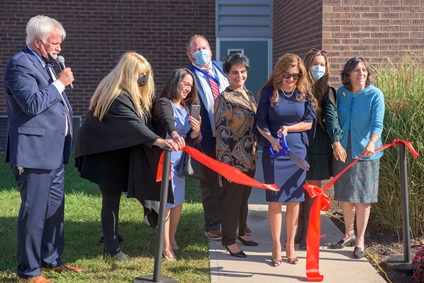 NJTESOL/NJBE would like to congratulate Mercer County Technical Schools on the opening of the Hernandez Newcomer SLIFE Academy! On September 30, 2021 this groundbreaking event took place at the Arthur R. Sypek Center of MCTS. This is the first academy in New Jersey to focus specifically on multilingual students. NJTESOL/NJBE Executive Board member, Mercer County Superintendent of Schools, and academy namesake, Yasmin E. Hernάndez-Manno, cut the ribbon at a ceremony attended by educational dignitaries, representatives from Governor Murphy’s office, and MCTS staff. The Culinary Arts Academy students created and served an exquisite menu of hors d’oeuvres.
NJTESOL/NJBE would like to congratulate Mercer County Technical Schools on the opening of the Hernandez Newcomer SLIFE Academy! On September 30, 2021 this groundbreaking event took place at the Arthur R. Sypek Center of MCTS. This is the first academy in New Jersey to focus specifically on multilingual students. NJTESOL/NJBE Executive Board member, Mercer County Superintendent of Schools, and academy namesake, Yasmin E. Hernάndez-Manno, cut the ribbon at a ceremony attended by educational dignitaries, representatives from Governor Murphy’s office, and MCTS staff. The Culinary Arts Academy students created and served an exquisite menu of hors d’oeuvres.
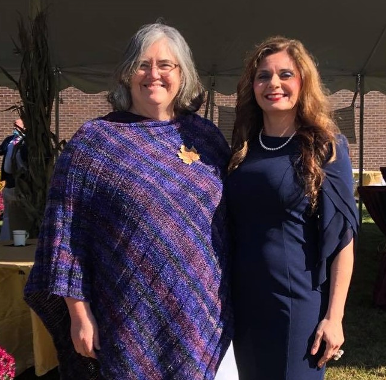
Kathleen Fernandez (left) with Yasmin Hernάndez-Manno
A unique program, the Newcomer Academy offers Mercer County high school students who are new to the United States English language development instruction, math, and general educational classes. In addition, they are also able to participate in a CTE (Career and Technical Education) path to work success. Students currently enrolled are participating in Auto CAD and ServSafe (culinary) courses.
The first cohort of students speak Spanish and Haitian Creole, coming from a variety of countries and Mercer County communities. Program teacher, Julie Trauger, describes the Newcomer curriculum with Mick Orfe and David Nash on The MCTS Experience Podcast.
Maribelle Robinson is ESL/World Language Supervisor and the administrative leader of this essential program.
Information on the program can be found on the Mercer County Technical School website and registration for the 2022-2023 school year is going on now.
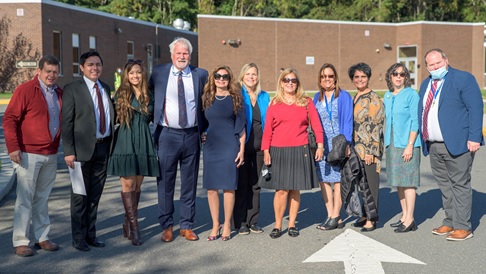
Culturally Responsive Teaching: Taking Small Steps Toward Equity
By Chris Kubic
 In this article, Chris Kubic sorts through the overwhelming amount of resources on equity by breaking them down to two areas so that providing equity is more doable.
In this article, Chris Kubic sorts through the overwhelming amount of resources on equity by breaking them down to two areas so that providing equity is more doable.
Diversifying Explicit Curriculum
Kubic begins with what is taught, being sure it doesn’t overemphasize any single perspective. He cautions educators to be careful that books representing diversity do not project stereotypes, and that if better resources cannot be found, then to discuss the problems of these minority representations with your students.
Diversifying Implicit Curriculum
His second step is to check peripheral materials such as music, images, and quotations that may accompany lessons to be sure that they reflect the diversity of your students. Kubic’s solution is to ask his students for memes, pictures, and quotations that they like.
He concludes that, “These efforts will bear fruit in making a more equitable curriculum and classroom experience.” He recommends reading We Got This. Equity, Access, and the Quest to Be Who Our Students Need Us to Be
You can read the article here.
October 19, 2021
The Seal of Biliteracy
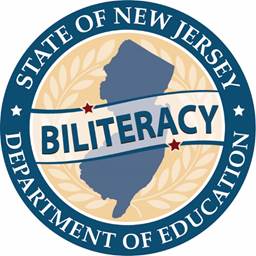 “The State Seal of Biliteracy was established to recognize high school graduates who have attained a high level of proficiency in speaking, reading, listening and writing in one or more world languages, in addition to English.” (Seal of Biliteracy brochure)
“The State Seal of Biliteracy was established to recognize high school graduates who have attained a high level of proficiency in speaking, reading, listening and writing in one or more world languages, in addition to English.” (Seal of Biliteracy brochure)
The Seal of Biliteracy was first initiated in California in 2008 and was legislated there in 2011. It is an initiative that In New Jersey, NJTESOL/NJBE and FLENJ, the Foreign Language Educators of New Jersey, piloted the program here from 2013 to 2015. Twenty-four districts participated in the pilot in the last year before New Jersey officially adopted the Seal of Biliteracy on January 19, 2016. NJ was the 15th state to join this initiative.
NJTESOL/NJBE encourages districts to support our Emerging Bilinguals in achieving this distinction. Oftentimes, students qualify through their World Language classes and efforts are not made to include EBs – Emerging Bilinguals. We need to advocate for our students to demonstrate their Biliteracy skills.
The NJDOE website has valuable information. Districts must opt in to participate and each year that number increases. According to the timeline, the state will be sending information to the school districts later this month. Students can test in the second half of their junior year or anytime through the beginning of March of their senior year. The site lists the requirements and the testing options.
In addition to the website, the downloadable brochure beautifully lays out a brief history of the seal, its purpose, requirements, and testing criteria.
Thank you to Elizabeth Franks for her input above and especially for helping to initiate the Seal of Biliteracy in New Jersey.
What makes someone bilingual? There’s no easy answer.
 By Xavier Aparicio
By Xavier Aparicio
Quoted at the top of the article:
“There are a million different ways to be bilingual.”
(Gerd Altmann/Pixabay, CC BY-SA)
Xavier Aparicio presents several theories of what bilingualism is. An ideal definition, dating from 1930, is that someone who is truly bilingual is equally fluent in both languages. A second theory is that someone who is bilingual uses both languages throughout the day. Yet another theory allows for partial mastery of the second language.
In following this up, the author observes that there are varying levels of skills in individuals in speaking, writing, and comprehension, and some are stronger in one skill than in another. Generally, though, one language becomes dominant depending on where the person lives, and this might not be the person’s first language.
He then notes two hypotheses about how a bilingual person speaks in one of the languages. Is one suppressed when using the other, or does the person draw from both?
Aparicio recognizes that language learning should be encouraged, especially for young children. His conclusion is that “There are many different paths to bilingualism. While it is not an easy concept to define – and doing so can sometimes be stigmatizing – it is important to value all languages and their various uses.”
You can read the article here.
October 26, 2021
Quick and Easy Grammar Explanations: The Simple Past and the Present Perfect
By Marilyn Pongracz
 For students taking ESL classes in college, grammar is necessary, and for high school students, some grammar lessons are helpful. In the college grammar texts, the verb tenses are often taught one at a time, and in many grammar books with all of the nuances and variations, students become thoroughly confused.
For students taking ESL classes in college, grammar is necessary, and for high school students, some grammar lessons are helpful. In the college grammar texts, the verb tenses are often taught one at a time, and in many grammar books with all of the nuances and variations, students become thoroughly confused.
Eli Hinkel in “Research Findings on Teaching Grammar” includes the present perfect and simple past as being among the essential grammatical structures used in academic writing.
To explain the simple past, we say that it is something that was finished at a specific time. Usually, all that is needed is an -ed at the end of the verb. The list of irregular verbs seems daunting, but we don’t use some of the words, so this shortens the list. The other good news about the irregular verb list is that it includes all of the irregular past tense verbs. Less frequently used verbs all end with -ed. The question we use in tutoring to help students find and correct their errors is, “What time are you talking about?”
The present perfect is used when no time is specified. It may be something that has an effect on the present. For example, “I have just eaten, so no thank you, I don’t want a bagel.” It could also be used for something that has happened in the past and is going to happen again. “We have had two quizzes this semester. Yes, there will be more quizzes.”
The present perfect is formed using have or has as the helping or auxiliary verb plus the past participle of the main verb. Again, this usually has an -ed ending, and the list of irregular verbs contains most of the words in the past tense list. Of course, the first time students see have had, they look at us like we have two heads, so we need to explain that the first instance is the helping verb and the second is the main verb.
Marilyn Pongracz is the ESL Tutoring Supervisor at Bergen Community College.
4 Activities to Practice Simple Past and Present Perfect
 By A. C. Kemp
By A. C. Kemp
A. C. Kemp chose these two tenses because they are the ones that students make the most errors using. She describes four activities for student practice.
The first two are for practicing the past tense. Students work in small groups telling the story of a movie without naming the characters and the others have to guess the title of the movie.
For the second activity, students sit in a circle. One student gives the setting of a story and names the characters. The second student adds a sentence to the story starting with the word, unfortunately. A third student adds another sentence starting with the word, fortunately, and the pattern continues until all of the students have added a sentence.
The other two activities are for practicing the present perfect. Kemp suggests using 9-12 descriptions of things that someone might have done. Students have to “Find someone who…” For example, “…has walked their dog today.” Students have to use complete sentences to ask and answer the questions and find different classmates for each description.
For the last activity, “Never Have I Ever”, everyone holds up 10 fingers. Students tell about something they have never done but someone else might have. Anyone who has done that puts a finger down. The winner is the student who has the most fingers up at the end of the game.
Readers have responded with high ratings of these activities and with variations of them.
See the examples and specific instructions.
November 2, 2021
NJEA Convention Returns to Atlantic City with Workshops Supporting Multilingual Learners
By Michelle Land

Henry Louis Gates Jr.
The pandemic has affected how we do even the most habitual things. The first weekend in November usually sees a migration of all sorts of educators down to Atlantic City to participate in the annual NJEA Convention. This year, NJEA has taken the bold step to return in person to Atlantic City this week for its annual NJEA Convention while also providing a virtual option. The themes this year are “equity-justice-learning”. There are several opportunities to attend PD sessions that address how to support multilingual learners.

Bill Nye
In order to attend in person, you must register for any workshop you want to see. No walk-ins will be permitted. This allows for contact tracing as well as social distancing. Another way that NJEA is addressing safety is the need for proof of vaccination or a negative PCR test. In addition, all participants must wear a mask, food and beverages must be consumed in designated areas, and capacity in workshops will be reduced.
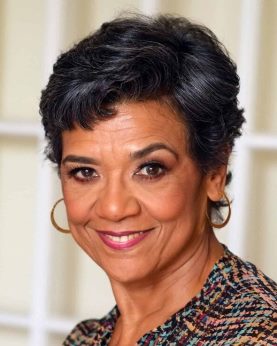
Sonia Manzano
The keynote speakers are well worth the visit – Emmy Award-winning filmmaker, literary scholar, journalist, cultural critic, and institution builder Henry Louis Gates Jr., the American science educator, television presenter, author, and inventor Bill Nye, actor and author Sonia Manzano (Maria from Sesame Street!) and Eric Liu, Citizen University CEO. Three of the four will be presenting in person (Bill Nye will be presenting virtually).

Eric Liu
On Thursday at 10:30, our very own LeighAnn Matthews will be “Advocating for Multilingual Learners: Past, Present, and Future”. At 12:15, I will be diving into the new WIDA 2020 Standards Framework with participants. At 2 pm on Thursday, Dr. Johanna Amaro will be sharing information about UDL(Universal Design for Learning) for ELLs.
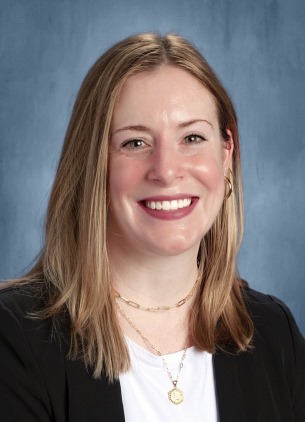
LeighAnn Matthews
On Friday, there are also several sessions supporting multilingual learners to choose from! You can start your day after the keynote learning about diversifying your classroom with Marisol Espinoza. If you are more interested in culturally responsive classrooms for ELLs, then Dr. Johanna Amaro and Monica R. Goncalves may be the presenters to seek out. Racial and cultural competencies in educational settings is also bound to be of interest with presenters Carmen Torres-Izquierdo and Mercedes Valle.
On Friday at 12:15, Mr. Jason Velante Sr will be revisiting old school pedagogy in new ELL teaching. Finally, at 2 pm, Staci Anderson will share her expertise on trauma informed approaches to ESL.
While there is so much more that the convention offers for all learners, these are some of the highlights that teachers of multilingual learners might want to plan for.
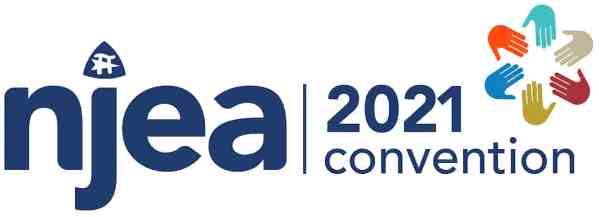 If you are interested in workshops for multilingual learners, there are a lot to choose from. Remember! You must register ahead of time if you are interested in attending one of these in person.
If you are interested in workshops for multilingual learners, there are a lot to choose from. Remember! You must register ahead of time if you are interested in attending one of these in person.
See you in Atlantic City!
Michelle Land was the Vice-President of NJTESOL/NJBE, 2020-2022.
November 9, 2021
Less Jargon, More Grace: Using Language That Parents Understand
By Tracy Edwards
 Tracy Edwards focuses on an important concept for ESL and Bilingual educators to remember as we head into parent conference season, the need to make information accessible for our student’s families. When parents do not feel that they understand what teachers and administrators are talking about, they can be intimidated or embarrassed at what they perceive is their own ignorance. This article is not exclusive for multilingual parents or guardians, but for all who are not familiar with school jargon.
Tracy Edwards focuses on an important concept for ESL and Bilingual educators to remember as we head into parent conference season, the need to make information accessible for our student’s families. When parents do not feel that they understand what teachers and administrators are talking about, they can be intimidated or embarrassed at what they perceive is their own ignorance. This article is not exclusive for multilingual parents or guardians, but for all who are not familiar with school jargon.
Edwards provides some examples of what we could say to improve communication with families:
- Instead of “cohort,” use “groups.”
- Instead of “e-learning,” use “learning that happens on a computer, tablet, or phone.”
- Instead of “Tier 1,” use “whole class lessons or instructions.”
- Instead of “Tier 2” and “Tier 3,” use “lessons for small groups (Tier 2) or individuals (Tier 3).”
- Instead of “IEP,” use “individualized education program for students with disabilities.”
- Instead of “accommodations” use “help provided to meet a student’s particular needs.”
Edwards recommends, “Drop the acronyms and educational jargon.” Terms such as scaffolding and I&RS are common for teachers, they are confusing or unknown to parents. To create a strong educational community including parents, remember that our “educational language” is not understood by everyone. Clear communication in every language is essential for parent/child/school engagement.
You can read the article here.
Contributed by Kathleen Fernandez, NJTESOL/NJBE Executive Director
NJTESOL/NJBE Multilingual Parent/Family Support
 In the past year, NJTESOL/NJBE has had two committees working on increasing support materials and information for multilingual parents and families. The result of these efforts is the new Parent Resources page on our website (under the Links & Resources tab). These resources were developed by the Parent’s rights committee and the Parent Expo Committee.
In the past year, NJTESOL/NJBE has had two committees working on increasing support materials and information for multilingual parents and families. The result of these efforts is the new Parent Resources page on our website (under the Links & Resources tab). These resources were developed by the Parent’s rights committee and the Parent Expo Committee.
The Parent’s Rights committee created a video outlining school requirements and code which families need to know and then translated it into eight different languages. Here is the playlist of all available languages: Spanish, Chinese, Haitian Creole, Korean, Turkish, Arabic, Gujarati, and Portuguese. The translated PowerPoint document is in the video description area and can be downloaded. The video and PowerPoint are also available in English so that administrators and other school staff can understand the information as well.
The Parent Expo is an event to bring even more information to multilingual families. Our next Parent Expo is a free virtual event on Saturday, January 22, 2022 at 9:30 am. The Parent Expo committee has gathered speakers and resources from a variety of areas to provide support on topics including health and safety, immigration, and technology. The resources from last June’s Parent Expo are already posted on the Parent Resources page.
January’s upcoming Parent Expo will focus on preparing for high school and high school options, including going to a Vocational and Technical high school. There will be information on the ASVAB, joining the military, and applying to college.
These materials and resources are not only a support for parents and families, but for teachers too. The videos and documents can be shared in parent meetings and with colleagues. NJTESOL/NJBE hopes that this storehouse of information will enable our multilingual learners, families, and teachers to navigate the larger educational system and their communities with confidence because they have more information.
By Kathleen Fernandez, NJTESOL/NJBE Executive Director
 Padres con Poder
Padres con Poder
Parent Power
Free Parent Workshop
Saturday, January 22, 2022 at 9:30
November 16, 2021
2022 NJTESOL/NJBE Spring Conference
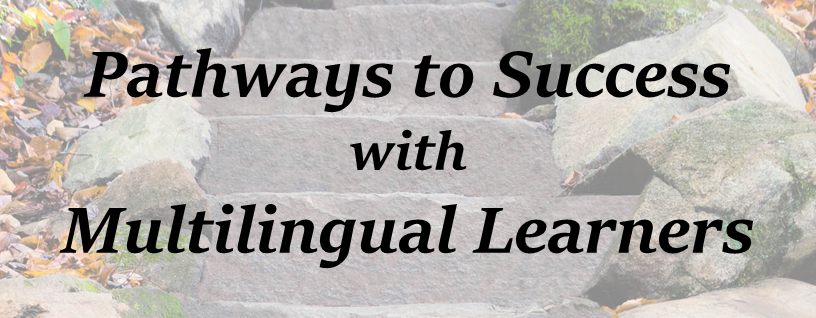 Registration is available online NOW!
Registration is available online NOW!
Our 2022 conference has two components to choose from:
In-Person Conference – June 1, 2, & 3 – Wednesday, Thursday, & Friday
Hyatt Regency Hotel, New Brunswick
OR
Video Library Conference – Access from June 4th through September 5th
Free NJTESOL/NJBE membership included with paid registration
The In-Person Conference will take place at the Hyatt Regency, June 1, 2 & 3.
- You can register for one, two or all three days.
- Presentations on multiple topics every day. Three fantastic Keynotes and special invited guests scheduled to present at the conference. (See below)
- Interact with other attendees!
- Visit and meet at the Sponsor & Exhibitors booths.
- Earn PD Hours throughout the day.
- *If you register for our 2 or 3 days In-person Conference, you also have access to the Video Library Conference.
The Video Library Conference is a Select Collection of library workshops you will have access to view from June 4th through September 5th using our conference platform.
- There is no set schedule.
- Earn PD hours through June 30; your hours will be tracked each time you log in.
- Visit the Sponsor’s virtual booths.
- Please note that the Select Collection of workshops will not include the Keynotes or Some Invited Guest Speakers. There is no Q&A.
Call for Workshops
Please share your amazing lessons, strategies, etc. by submitting a workshop proposal.
The deadline has been extended to November 28, 2021.
Submit an In-Person workshop, Video Library workshop or both.
Please use this link for more information and to submit a proposal.
Visit our website for more information.
For other conference questions email:
Sandee McBride, the Conference Coordinator or Michelle Land, the Vice-President
November 23, 2021
7 Steps to Increasing Active Spoken Vocabulary
 In her blog posts, A.C. Kemp offers a variety of ideas about getting students talking in ESL classes. Some, which are warmups from improv, are easy and fun and could help lower students’ affective filters so they are more comfortable opening up. In addition to basic speaking activities, she also offers tips for impromptu speaking and online presentations.
In her blog posts, A.C. Kemp offers a variety of ideas about getting students talking in ESL classes. Some, which are warmups from improv, are easy and fun and could help lower students’ affective filters so they are more comfortable opening up. In addition to basic speaking activities, she also offers tips for impromptu speaking and online presentations.
7 Steps to Increasing Active Spoken Vocabulary is a flexible, systematic plan that students can follow. The list includes guidelines for teachers.
- Students should keep a vocabulary journal and in it, make a list of words or idioms that they have heard or read. They should be familiar with the words that they choose but not yet use them in speaking.
- They should look up each word in a learners’ dictionary for pronunciation and usage and write down the information they have learned.
- Students make notes about when they might be able to use the word, perhaps in class or casual conversation.
- When they try to use each word, they should note whether their attempt was successful or not.
- If they hear a word or phrase that is not on the list, they can add it to their list or exchange it for a word that they noted earlier.
- When they hear a word they want to add, they should try using it immediately.
- In class, after a week has passed, students report on what they learned, tell what worked and what did not, ask questions, and finally submit the list and notes to the teacher.
You can check A. C. Kemp’s blog for ideas that might be helpful for your classes.
Memorable Teachers
By Marilyn Pongracz
 With the holidays, and especially Thanksgiving, I think back thankfully on those who have taught me memorable and useful lessons. In high school, I had a history teacher who taught us to examine and question the popular political ideas of the day. This was during the Cold War era, and we thought he was trying to turn us into Communists. However, I learned to look objectively at what people say.
With the holidays, and especially Thanksgiving, I think back thankfully on those who have taught me memorable and useful lessons. In high school, I had a history teacher who taught us to examine and question the popular political ideas of the day. This was during the Cold War era, and we thought he was trying to turn us into Communists. However, I learned to look objectively at what people say.
There were other teachers as well, although not necessarily in a classroom. Before going overseas to live in a country where the culture was quite different from what we knew, we attended cross-cultural classes to help us accept the other culture as equally good and perhaps in some ways better than our own. Once there, a man who was familiar with what foreigners didn’t know, patiently, in friendly visits, taught us specifically what was culturally acceptable and why.
When I was back in the United States, personal computers intrigued me. At my job as the ESL Tutoring Supervisor at Bergen Community College, a student who worked for me as a receptionist introduced me to computer keyboard shortcuts and website html code.
In addition, for me, books play an important role as teachers of new perspectives. Most recently, some of my teachers are those wonderful people on YouTube who guide us on how to do almost anything.
Who are the teachers who stand out to you? You can email me to share your stories here, too.
Marilyn Pongracz is the ESL Tutoring Supervisor at Bergen Community College and the Technology Coordinator for NJTESOL/NJBE.
November 30, 2021
Why Mixing Languages Can Improve Students’ Academic Performance
By Rasman
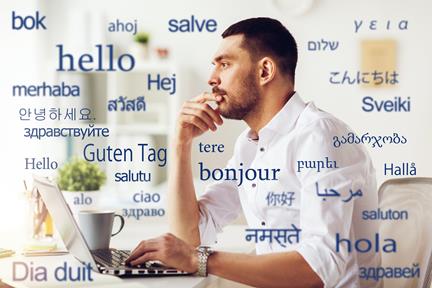 Rasman notes that in many parts of the world, mixing languages is labeled with a pejorative, and this implies that this practice is perceived as a deficiency. However, he argues that research has shown the opposite to be true. In fact, he points to three aspects of learning which support the premise that multilingual strategies are beneficial for students.
Rasman notes that in many parts of the world, mixing languages is labeled with a pejorative, and this implies that this practice is perceived as a deficiency. However, he argues that research has shown the opposite to be true. In fact, he points to three aspects of learning which support the premise that multilingual strategies are beneficial for students.
“First, multilingual skills help students to activate their prior knowledge, which positively affects the process of understanding new knowledge.” This prior knowledge exists in the student’s first language, so it requires the use of that language to access that knowledge.
“Second, multilingual skills help build rapport between students and teachers, which is important for improving academic performance.” A good rapport is vital to students’ learning through meaningful interactions, so that they become involved in their learning.
“Third, multilingual skills help increase students’ well-being, which is a key factor in successful learning.” When students’ cultural identity is accepted, they feel socially included, and can develop good relationships with their teachers and peers. This, in turn, also promotes academic success.
You can find the complete explanations here.
Translanguaging: Theory, Concept, Practice, Stance… or All of the Above?
By Marybelle Marrero-Colon
 Marrero-Colon explores the concept of translanguaging and its application in varying types of programs.
Marrero-Colon explores the concept of translanguaging and its application in varying types of programs.
She answers the questions:
- What exactly is translanguaging?
- How is translanguaging defined?
- What is the difference between translanguaging and code switching, as well as the other terms that are used to describe this type of language use?
- Are there multiple definitions of the term/concept?
- How is translanguaging defined and applied within the context of the classroom?
- How do different program models provide opportunities for translanguaging in classroom instruction?
First, Marrero-Colon discusses various theories of how multilinguals process their different languages in the brain and the limitations of each of these theories, finishing with translanguaging, which views language as a “system of fluid language practices,” resulting in the possibility of being fully fluent in two or more languages.
She describes translanguaging as the “simultaneous use of two or more languages” ; … in which multilinguals make use of all of their communicative resources for meaning and communication. “Fundamentally, translanguaging promotes both first and second language development while honoring the home languages and identities of the students.”
The author’s research is to encourage best practices rather than what often occurs in the classroom, in which content is taught separately from language without the use of students’ first languages. Research has shown that use of students’ first language supports content mastery in the second language when language and content are taught together. For example, if students understand concepts in their first language, the teacher can use that language to teach the vocabulary for the same concepts in students’ second language.
Marrero-Colon lists the advantages of translanguaging:
- It may promote a deeper and fuller understanding of the subject matter.
- It may help the development of the less dominant language.
- It may facilitate home-school connections and cooperation.
- It allows the integration and collaboration of language learners from all proficiency levels, from advanced or native multilingual speakers to those who are in the earlier stages of language acquisition.
She adds that, for native English speakers, content classes that promote translanguaging would provide “exposure to other languages and cultures.”
In the classroom, translanguaging is used strategically so that what is learned in one language is then practiced and internalized in the other” and the connections between languages “is deliberate and well planned.” The author describes how this can be carried out in different types of programs: ESL instruction, transitional bilingual education, dual language education and gives examples of these best practices.
Marrero-Colon concludes that “Fundamentally, translanguaging promotes both first and second language development while honoring the home languages and identities of the students.”
Throughout the article, the author gives examples of these best practices. You can find them here.
December 7, 2021
How Culturally Responsive Lessons Teach Critical Thinking
By Clint Smith
 Clint Smith begins the article with his own experience growing up in New Orleans with the names of confederate soldiers and slave owners on roads, buildings and schools, and not being able to articulate what was wrong.
Clint Smith begins the article with his own experience growing up in New Orleans with the names of confederate soldiers and slave owners on roads, buildings and schools, and not being able to articulate what was wrong.
He argues that to fully understand the events of the present, students must be taught the truth of the past rather than on carefully crafted myths.
…we are so committed, often unconsciously, to the idea of American exceptionalism, that we often suppress anything that would render our history, and thus our country, unexceptional. In our classrooms across the country, our textbooks soften the contours of America’s most violent deeds and most malevolent people to present something more palatable, even if it is, as a result, dishonest.
Smith calls for teaching a balanced view of history, both the good and the bad. “Teachers attempting to bring American history into the classroom should not singularly focus on a false narrative of American exceptionalism, just as they should not singularly focus on its violence without accounting for its virtues.”
A common belief is that if what is taught is culturally responsive, it cannot also be rigorous. But the author refutes that idea by stating that it actually takes a high level cognitive skill to comprehend the nuances of history that the heroes of the past were not only heroes, but that they also held flawed ideologies. “We do not have to choose between a rigorous lesson and a culturally responsive one. Our current political moment, and indeed our nation’s history, demands both.”
See the details and an excerpt of a speech by Abraham Lincoln.
A Book Study
Linguistic Justice: Black Language, Literacy, Identity, and Pedagogy
By Dr. April Baker-Bell
By Kathleen Fernandez
 Recently, members of NJTESOL/NJBE were invited to participate in a book study, Linguistic Justice: Black Language, Literacy, Identity, and Pedagogy by Dr. April Baker-Bell, our Spring Conference speaker for Wednesday, June 1. It is right to look at this work as part of teaching culturally responsive lessons for critical thinking.
Recently, members of NJTESOL/NJBE were invited to participate in a book study, Linguistic Justice: Black Language, Literacy, Identity, and Pedagogy by Dr. April Baker-Bell, our Spring Conference speaker for Wednesday, June 1. It is right to look at this work as part of teaching culturally responsive lessons for critical thinking.
The study revealed that many of us were unaware of cultural differences in the everyday lives of our BIPOC students, including those that are learning English. In her book Baker-Bell describes “the linguistic violence, persecution, dehumanization, and marginalization that Black Language-speakers experience in schools and in everyday life. Anti-Black Linguistic Racism as a framework explicitly names and richly captures the type of linguistic oppression that is uniquely experienced and endured by Black Language-speakers.” (Baker-Bell, 2020).
In speaking with the group, Baker-Bell pointed out that anti-black racism is normalized and embedded in traditional pedagogies. Black students are told that the language they speak is not a language at all, which results in linguistic dehumanization, and requires students to reject their language. Instead, teachers should validate and begin with the language that students bring into the classroom to develop students’ linguistic consciousness of “mainstream white English”.
To create those culturally responsive lessons it requires having critical literacy conversations about the function of language in society and school in particular. Lessons should include opportunities for students to experiment with language forms, including their own language, and value all languages as equal in status. Recognize solidarity between Black and Latinx students in the intersections of language and race and de-center white language in the classroom. Students and teachers must know the intersections of language and race, language and grammar, language and culture, language and history (of the language). Thinking critically about these concepts will orient the school community around diversity and the importance of language and language identity.
For some, this is a difficult change to make. We are all socialized into anti-Black linguistic racism. Teachers say they are there to educate all students, therefore they should allow students to use their own language for literacy. Denying students the right to use their language is to deny their humanity. All children should be aware of the value of Black language and teachers should be accountable to recognize the historic development of Black language in this country.
Students can master thinking critically about linguistic racial justice by allowing them the power to question and research language usage in education and society. Enable them to see that the Black language valued in entertainment culture can be valued in education as well. This will happen when we, as educators, empower our students to be true to themselves linguistically and racially by acknowledging their personal background independent of “mainstream white English” norms.
Kathleen Fernandez is the NJTESOL/NJBE Executive Director.
December 14, 2021
Call for Submissions to the Annual Voices Journal
Dear Members,
 It seems like yesterday, but it has been more than a year since NJTESOL/NJBE revised our Voices Quarterly Journal to Weekly Voices and our annual Voices Journal. We have heard positive feedback on this change and hope all of our members are enjoying these publications. NJTESOL/NJBE Voices Journal is an annual winter publication and we are looking for articles from our members now with a submission deadline of January 15. To promote all voices in our organization and in support of our Spring Conference theme we encourage articles from Black, Indigenous, and people of color (BIPOC) members and/or topics that focus on race and power within language instruction, or linguistic justice more broadly. Submission guidelines indicate articles in these categories:
It seems like yesterday, but it has been more than a year since NJTESOL/NJBE revised our Voices Quarterly Journal to Weekly Voices and our annual Voices Journal. We have heard positive feedback on this change and hope all of our members are enjoying these publications. NJTESOL/NJBE Voices Journal is an annual winter publication and we are looking for articles from our members now with a submission deadline of January 15. To promote all voices in our organization and in support of our Spring Conference theme we encourage articles from Black, Indigenous, and people of color (BIPOC) members and/or topics that focus on race and power within language instruction, or linguistic justice more broadly. Submission guidelines indicate articles in these categories:
- Current issues: a submission for the current issues category should provide a clear analysis, critique, discussion, or presentation of key topics in New Jersey ESL, Bilingual Education, and Dual Language programs.
- Classroom explorations: a submission for the classroom explorations category will enable teachers to share their personal perspectives on their own instructional techniques, challenges, issues, and successes. It should include viewpoints in developing multiple avenues to address the range of issues in ESL, Bilingual Education, and Dual Language education and student learning. Each submission should include the type of program, the instructional techniques, and overview in the first paragraph, then provide supporting evidence throughout the rest of the article.
- Program descriptions/exemplary scheduling: a submission for this category will detail a school or district program that has created a solution to an issue impacting effective instructional settings for English language learners, bilingual students, and dual language learners. These programs do not need to be all encompassing, but rather provide insight into creative strategies for scheduling and/or lesson planning to enhance student learning.
- Alternative perspectives: a submission in this category will provide an opportunity for diverse perspectives on one issue or topic. We encourage innovative commentary on issues or teaching methodologies as a way of including all voices in a professional conversation.
Articles should be current and appropriate as related to the teaching of English to speakers of other languages, Bilingual Education, and Dual language programs including students who are U.S.-born bilinguals, ethnically and/or racially diverse multilingual speakers, “generation 1.5”, immigrants, and international students. Articles may focus on any educational level, from kindergarten to university, as well as on adult school and workplace literacy settings. Article length is recommended to be from 500-1200 words and photos are accepted. In recognition of disproportionate impacts upon Black language learners, we encourage submissions at the intersection of race and language. Please check the complete guidelines here.
NJTESOL/NJBE thrives on the scholarship and teaching skills of its members. Please take the time to share some of your expertise with your colleagues in NJTESOL/NJBE Voices Annual Journal. Deadline for submission is January 15, 2022. Click here for submission information.
Thank you,
Kathleen Fernandez, Executive Director NJTESOL/NJBE
Articles from Last Year’s Annual Voices Journal
 Designing Assessments to Facilitate Oral Language Development
Designing Assessments to Facilitate Oral Language Development
Margaret Churchill, Kevin Calixto, and Maria Cecilia Vila Chave
WIDA’s Key Language Uses target specific language features; the discussed assessments focus on communicative construction across the four domains to evaluate explicit academic purposes and linguistic patterns needed to build language proficiency in English.
Cultivating Joy: An Introspective on Developing ESL Practitioners of Color
Kristen Vargas and Tasha Austin
The interaction of the experience of a pre-service teacher of color with the dominant narrative in teacher education and the use of a critical lens to evaluate the outcome.
Current and Former English Language Learners (ELLs): Supporting the Transition from Secondary Schools to College
Hana Prashker, Patricia George, and Elizabeth Franks
A discussion on steps and interventions to support ELLs through high school graduation into enrollment and success at college.
Globalization To The Rescue!
Pedro Trivella
Educating for global competence increases students’ classroom engagement and future success through planning which includes a cultural lens and critical thinking.
To Google Translate or Not Google Translate?
Amanda Guarino and Angello Villarreal
Views on using cognates and translations for students with and without a solid academic foundation in their native language, bridging content connections between their native language and English.
 Visit our home page for links to past and present Voices issues.
Visit our home page for links to past and present Voices issues.
